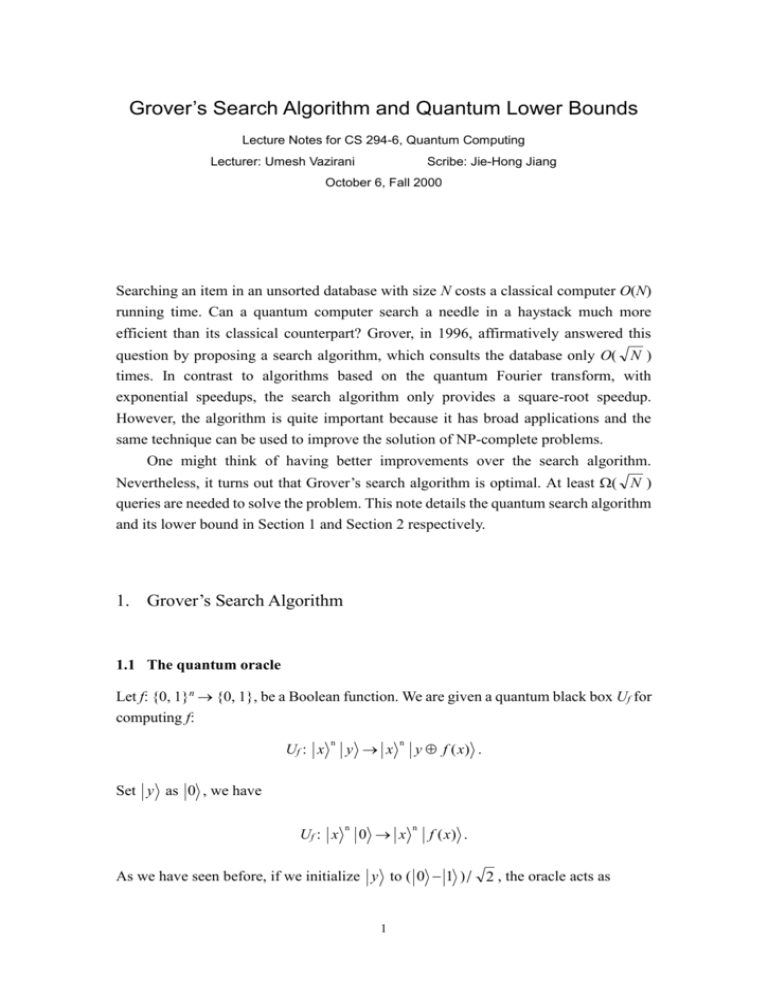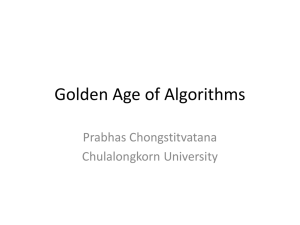Grover`s Search Algorithm and Quantum Lower Bounds
advertisement

Grover’s Search Algorithm and Quantum Lower Bounds
Lecture Notes for CS 294-6, Quantum Computing
Lecturer: Umesh Vazirani
Scribe: Jie-Hong Jiang
October 6, Fall 2000
Searching an item in an unsorted database with size N costs a classical computer O(N)
running time. Can a quantum computer search a needle in a haystack much more
efficient than its classical counterpart? Grover, in 1996, affirmatively answered this
question by proposing a search algorithm, which consults the database only O( N )
times. In contrast to algorithms based on the quantum Fourier transform, with
exponential speedups, the search algorithm only provides a square-root speedup.
However, the algorithm is quite important because it has broad applications and the
same technique can be used to improve the solution of NP-complete problems.
One might think of having better improvements over the search algorithm.
Nevertheless, it turns out that Grover’s search algorithm is optimal. At least ( N )
queries are needed to solve the problem. This note details the quantum search algorithm
and its lower bound in Section 1 and Section 2 respectively.
1. Grover’s Search Algorithm
1.1 The quantum oracle
Let f: {0, 1}n {0, 1}, be a Boolean function. We are given a quantum black box Uf for
computing f:
Uf : x
n
y x
n
y f ( x) .
Set y as 0 , we have
Uf : x
n
0 x
n
f ( x) .
As we have seen before, if we initialize y to ( 0 1 )/ 2 , the oracle acts as
1
Uf : x
n
0 1
2
(1) f ( x ) x
n
0 1
2
.
Now suppose that there is a single value k such that f(k) = 1. If f is specified by a
black box, what is the fewest queries we must make to f to determine such k?
1.2 The iterative procedure
On searching an N-item database, Grover’s search algorithm uses the operator D
defined as
2
2
( N 1)
N
2
2
( 1)
D N
N
2
2
N
N
2
N
2
N .
2
( 1)
N
D has two properties:
(1) It is unitary and can be efficiently realized.
(2) It can be seen as an “inversion about mean.”
Proof:
(1) For N = 2n, operator D can be decomposed and rewritten as:
2
0
HN
0
D
1 0
0 1
HN
0 0
0
0
0
0
0
HN I
0
0
0
HN
1
HN
2 0 0
0 0 0
HN
I H
N
0 0 0
2
2
N
0
0
N
0
0
2
N
0 I
0
2
N
2
N
2
N
I
2
N
Observe that D be expressed as the product of three unitary matrices (two Hadamard
matrices separated by a conditional phase shift matrix). Therefore, D is also unitary.
Regarding the implementation, both Hadamard and the conditional phase shift
transforms can be efficiently realized within O(n) gates.
(2) When D operates on a vector and generates another vector , that is,
2
1
1
D i i ,
N
N
the ith amplitude i
2
j i 2 i ( i ) can be considered as an
N j
“inversion about mean” with respect to i , where is the average amplitude.
As shown in Figure 1, the operation of D increases (decreases) amplitudes that are
originally below (above) the mean value .
i
(a)
i
i
(b)
i
Figure 1: Effects of D operation. (a) States before operation. (b) States after operation.
The quantum search algorithm iteratively improves the probability of measuring a
solution. In each iteration, this algorithm performs two operations: first consult the
oracle Uf and then apply the “inversion about mean” operator D. The quantum state
evolves as i1 = DUf i along with iteration i to iteration (i+1).
Suppose we are finding one out of N items. In the first step, as shown in Figure 2
(a), we prepare the initial state as a uniform superposition over these N items. In each
iteration, Uf marks the only solution k, f(k)=1, with a phase shift as indicated in (b).
Then D operation amplifies k, the amplitude of the marked item, and suppresses those
of all other items as in (c). Repeating the process before measurement increases the
3
probability of measuring k. For example, after the first iteration, k 3
second iteration, k 5
N ; after the
N . More formally, at iteration t, k and l (l = 0, 1, , …, N –1;
l k) are
(kt ) (1
l(t ) (
Initially, (k0) l( 0) 1
2 (t 1)
2
) k (2 ) l(t 1)
N
N
2 (t 1)
2
) k (1 ) l(t 1) .
N
N
N . After O( N ) steps, k becomes constant. Therefore, in
the measurement, the probability of observing k becomes constant. Notice that
repeating iterations does not always increase the chance of measuring the right answer.
The amplitude of the marked solution goes up and down as a cycle. If we do not stop at
the right time, we might not have a good chance to measure the correct item.
i
(a)
i
k
i
(b)
k
i
i
(c)
k
i
Figure 2: Finding 1 out of N items. (a) Uniform superposition is prepared initially. Every item has equal
amplitude (1 /
N ). (b) Oracle Uf recognizes and marks the solution item k. (c) Operator D amplifies
the amplitude of the marked item and suppresses amplitudes of other items.
4
1
M
k
x
x f 1 (1)
DU f 0
0
2
u
1
N M
x
x f 1 ( 0 )
U f 0
Figure 3: Geometric interpretation of the iterative procedure.
1.3 The geometric interpretation
Suppose to find M solutions from a sample space with N entries. We can cluster these
1
items into two orthogonal bases, say k
x (collection of the M solutions)
M x f 1 (1)
and u
1
N M
x
(collection of the remaining items). Hence, Figure 3 can
x f 1 ( 0 )
visualize iterative steps in a single plane spanned by these two vectors. For original
state 0
0
1
N
M
N
N 1
x
, it can be rewritten as
x 0
1
M
N M
x
1 N
x f (1)
1
N M
M
N M
x
1 N k N u .
x f ( 0)
In the oracle consultation, Uf shifts the phase in the k component and therefore
reflects the acted vector about u . Meanwhile, since D is a reflection about 000 in
the Hadamard basis (refer the proof of property (1) of D in page 2), it reflects the acted
vector about 0 . The product of these two operators, DUf, performs an equivalent
2 -rotation operation, where sin 1
M
N M
. After i such iterations,
cos 1
N
N
5
the state becomes
DU
i
f
0 sin 2 i 1 k cos 2 i 1 u .
In the special case of finding 1 out of N items (N » 1), sin 1
N , to
maximize the probability of the correct measurement, the needed number of iterations
2 2 4N . Consequently, Grover’s search algorithm makes O(
N ) queries.
Through this visualization, it can be seen that if the number of iterations is not
chosen properly, the final vector might not be rotated to a right angle; a small
magnitude is projected onto the k direction, that is, we can only measure the right
answer with a small probability.
2. Quantum Lower Bounds
In light of previously developed quantum algorithms, one might ask if a quantum
computer can solve NP-complete problems in polynomial time. Consider the
satisfiability (SAT) problem, the first proven NP-complete problem. It can be
formulated as a search problem. That is, given a Boolean formula f(x1, x2, …, xn), search
an assignment under which the value of the expression is 1. Ask whether we can devise
a quantum algorithm to search within poly(n), or log N (N = 2n), steps. In the
following discussion, quantum lower bounds show that such a quantum speedup is
unlikely.
2.1 The hybrid argument
Consider any quantum algorithm A for solving the search problem. First do a test run of
A on function f 0. Define the query magnitude of x to be
2
x ,t
, where x,t is the
t
amplitude with which A queries x at time t. The expectation value of the query
magnitudes
E
x
t
2
x ,t
2
T
= N . Thus, min x ,t T N . Fix such an x, by
x
t
Cauchy-Schwarz inequality,
x,t
T
N
t
.
Now we modify the query on another function g: g(x) = 1, g(y) = 0 y x. Let
0 , 1 , …, T be the states of Af. Suppose the final state of Ag is T . We will
6
show that
T T
must be small.
Claim: T = T + E0 + E1 + … + ET 1 , where Ei is the error due to Step
i.
2.2 The quantum adversary method
References
[1]
[2]
[4]
[5]
A. Ambainis. Quantum lower bounds by quantum arguments. quant-ph/0002066.
C. H. Bennett, E. Bernstein, G. Brassard and U. Vazirani. Strengths and
weaknesses of quantum computing. SIAM Journal on Computing, Vol. 26, No.5,
pp 1510-1523, Oct. 1997.
L. K. Grover. A fast quantum mechanical algorithm for database search.
Proceedings of the 28th ACM Symposium on Theory of Computing, pp. 212-219,
1996.
U. Vazirani. On the power of quantum computation. Philosophical Transactions
of the Royal Society of London, Series A: Mathematical and Physical Sciences,
356: 1759-1768, August 1998.
7





